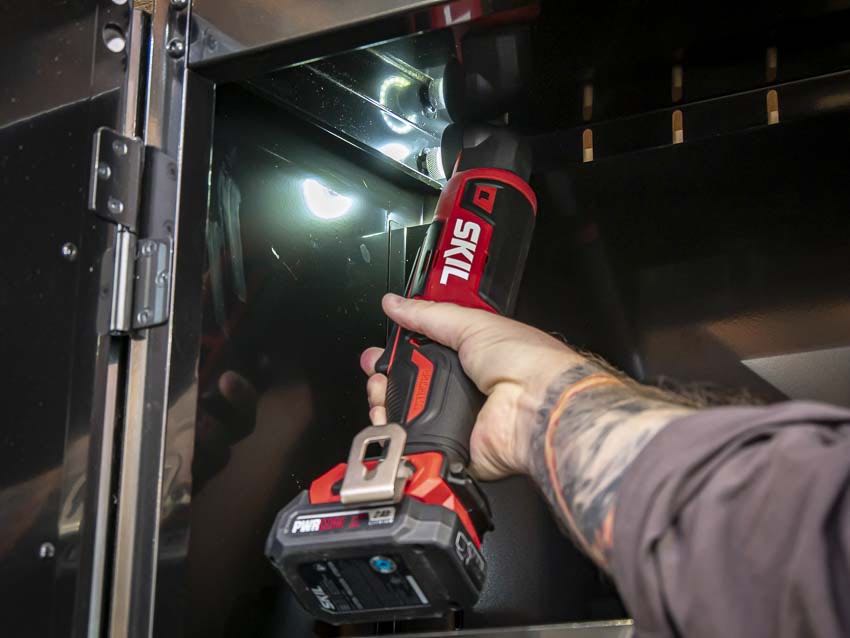Skil 12V Right Angle Impact Driver Sets Performance Benchmark at a Budget-Friendly Price
Skil’s PWRCore 12 line is primarily aimed at homeowners and DIYers who value a more compact design over the highest performance. So, you may be surprised to find a right angle impact driver on this system, since they’re more specialized tools than their standard counterparts. Skil actually has two different right angle impact drivers on this platform. Both have the same specs and performance, so which model should you add to your roster? I’ll walk you through each configuration so you have an idea of which is best for you.
Pros
- Higher speed and torque than 12V models from Makita and Milwaukee
- Accepts 1-inch hex shank bits to keep the head length down
- LED halo eliminates shadows
- Outstanding value ($109 kit)
Cons
- Slightly heavier than premium brands
- Head length is a little longer than premium brands
Skil 12V Right Angle Impact Driver Performance

- Model: Skil RI5745A-11 (USB-C battery config.); RI574502 (standard battery config.)
- Max torque: 900 in-lbs
- Max speed: 2700 RPM
- Max impact rate: 3750 IPM
- Variable speed paddle switch
- Collet: 1/4-inch
On paper, Skil’s right angle impact driver boasts speeds of up to 2700 RPM and torque levels topping out at 900 in-lbs. As an impact driver, it also produces a maximum impact rate of 3750 IPM. Compared to traditional impact drivers, even in the 12V sphere, those numbers aren’t anything to write home about, but they’re ideal for light- to medium-duty fastening applications, especially those in awkward spaces.
Keep in mind that a right angle tool doesn’t need the same kind of power and speed as standard models. The design doesn’t allow you to put as much force directly behind it as you would with standard impact drivers. When working in tight areas, this can cause the bit to become disengaged more easily. With too much power and speed, you could end up camming out screw heads.
When it comes to getting into that tight space, you can use 1-inch hex bits to minimize the total head length. This model’s head is 2.5 inches in total, making it a bit longer than premium competitors, but much shorter than any traditional impact driver.
Skil 12V Right Angle Impact Driver Design

- Weight: 2.5 lbs
- Length: 12.3 in
- Paddle trigger
- LED halo ring light
- Forward/lock/reverse switch
The Skil 12V right angle impact driver features a variable speed paddle trigger that’s just short of 4 inches long. With a small choil near the bottom of it, you have an effective grip from the base up to about the middle of the tool.
The advantage of having so much wiggle room on your grip is that you can get your hand out of the way when you need a longer reach. When you don’t need as much, you can shift your hand higher and get more stable bit engagement.
Then, there’s the LED halo ring light that surrounds the collet. We’re big fans of this type of work light on tools, and they work especially well on impact drivers thanks to their short collet design. They eliminate shadows more effectively than other work light designs, beating out both single and tri-beam arrangements.
As a bare tool, the Skil 12V right angle impact driver weighs 2.5 pounds, and it steps up to around 3.2 pounds when you add in a 2.0Ah battery. That’s a little heavier than some premium brands, like Milwaukee and Makita. For me, the slight weight increase is a trade-off worth making for the performance and value gains.
How Does it Compare?
Skil’s 12V right angle impact driver has an advantage over other brands in the price department, but how else does it stack up? Let’s take a quick look at some of the industry’s 12V cordless leaders: Milwaukee and Makita.
Note: We’re using Makita’s 12V max LT01R1 for comparison, but it looks like the brand has discontinued that model.
| Skil RI5745A-11 (This model) | Milwaukee M12 2467 | Makita LT01 | |
|---|---|---|---|
| Max Speed | 2700 RPM | 2425 RPM | 3000 RPM |
| Max Impact Rate | 3750 IPM | 3400 IPM | 3000 IPM |
| Max Torque | 900 in-lbs | 600 in-lbs | 530 in-lbs |
| Overall Length | 12.3 in | 11.3 in | 12.3 in |
| Head Length | 2.5 in | Not specified | 2.13 in |
| Price | $109 (kit) | $119 (bare) | $289 (kit) |
Skil 12V Right Angle Impact Driver Price and Model Comparison
This tool retails for $109 as a kit, including a 12V 2.0Ah USB-C battery and charger.
A kit with a standard non-USB-C battery and PWRJump charger is also available for $79. The only real difference between the two seems to be the battery, making this a bargain for those who don’t mind the older battery design. Don’t be surprised if this kit is on it’s way out once the current stock is sold, though.
With either configuration, Skil backs your purchase with a 5-year warranty.
Should You Buy It?
Against premium brands like Makita and Milwaukee, the Skil 12V right angle impact driver has a significant performance advantage. The trade-off is that it’s a bit heavier and the head isn’t as compact. However, its price is so much lower that it’s bound to get the attention of both Pros and DIYers.
So, should you buy it?
As I mentioned above, this is a specialty tool and not everyone needs a right angle impact driver. Most people who need awkward space drilling or driving help turn to a right angle drill first. However, when you’re fastening screws frequently (especially into metal) or working with hose clamps, the right angle impact driver is an excellent tool to have on hand, and Skil’s PWRCore 12 is a solid choice.
Normally, I’m all for DIY tools and professional tools staying in their own spaces, but this model has much more serious crossover potential than most. If your battery platform has a right angle impact driver available, it’ll probably work just fine. But if it doesn’t, save yourself some money and buy this one to have on hand when you need it.



